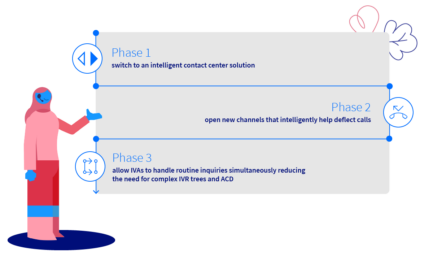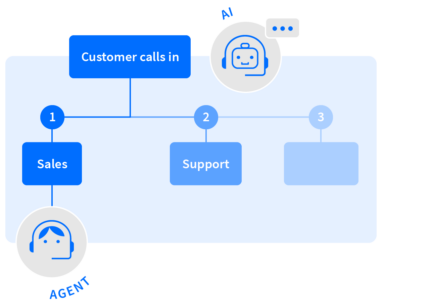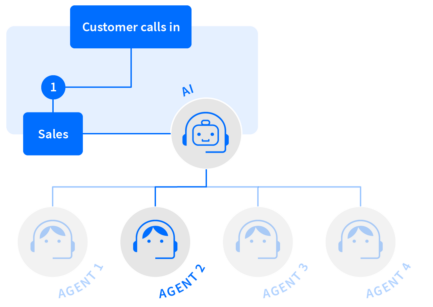Some say Intelligent Voice Routing (IVR) and Automatic Call Distribution (ACD) are dead.
The reality is a little more nuanced.
A 2024 Call Centre Helper Research Paper found that 89.9% of survey respondents still have IVR technology in their contact center, while 93.4% have ACD. Both numbers are slightly down from the previous year, yet they point to few simple truths that make complete displacement seem unlikely—at least for now:
- Many people still prefer to call customer service when they need help
- High case volumes remain a top priority for contact centers
- Contact centers need technology to efficiently route/handle calls
As long as some portion of customers still want to talk to people, we’re more likely to see augmentation and enhancement as the next steps in contact center AI.
We already see IVR evolving toward IVA (intelligent virtual assistant), which is capable of understanding and responding to complex natural-language queries, and almost more importantly, helping callers evade complex, and frustrating IVR trees. More recently, agentic AI has arrived on the scene, offering autonomous capabilities previously unseen.
Similarly, ACD is evolving toward optimized real-time call routing, and other advanced use cases.
Here are the principal reasons behind this trend and what, in practical terms, it looks like.

Source: ‘What Contact Centres are Doing Right Now’ (Call Centre Helper), page 7
It Makes Business Sense
Even when it stops short of complete displacement, the latest wave of AI-augmented IVR and ACD still delivers considerable business value. These make ideal solutions for the call center, that’s overwhelmed with return-call requests. Or the enterprise telecommunication brand ready to deploy AI-led use cases.
Wingo is a good example. With Bucher + Suter as their go-to partner for Webex Contact Center, the Wingo Customer Care team used the platform’s advanced routing capabilities to reduce their average speed of answer by more than ten seconds.
Wingo isn’t alone. Intelligent case and call routing, alongside conversational AI voicebots, played a key role when a global insurer cut average handle time by 27% with conversational AI.
In both instances, AI and automation didn’t entirely replace what we know as IVR and ACD; it helped these companies evolve from their traditional forms. Moreover, it created business outcomes that can be measured in dollars and cents.

It Improves Customer and Agent Experience
What’s good for contact center efficiency tends to bode well for agents and the customers they serve. For both audiences, the next step in the IVR/ACD evolution provides significant benefits.
Benefits of AI-Powered IVR, aka IVA
- Personalized, proactive recommendations
- Relief for overburdened support agents
- Consistent and accurate responses
- Continuous learning and support for agents
- 24/7 availability
Natural language processing (NLP) is core to IVA. IVA systems understand and respond to customer queries, in natural language, during voice and text interactions. This includes complex queries, such as you’ll find in financial services, enterprise technology, and other high-touch industries. What’s more, IVA handles these queries simultaneously, reducing the need for complex IVR trees and ACDs altogether.
AI also enables sentiment analysis for IVR. Using sentiment analysis, IVR systems can adapt responses based on the customer’s emotional state. When the system detects frustration, for example, it can automatically escalate calls.
Finally, AI opens the door to predictive analytics in IVR or IVA systems. As we’ve written elsewhere, conversational data is a contact center gold mine. The combination of conversational data and analytics can improve quality monitoring, predict customer behavior, and boost customer engagement.

Benefits of AI-Powered ACD
- Call routing based on customer data, agent skills, and real-time analytics
- Real-time adjustments to agent staffing based on predicted call volumes
- Better call management and routine task automation
- Generation of valuable insights from call data
AI-enabled ACD is known by another more common moniker: intelligent call routing. The ability to analyze calls and accurately route them improves first contact resolution, reduces wait times and transfer rates, and boosts CSAT. AI enables more sophisticated ACD, too, such as predictive, skills-based, priority-based, and location-based routing.
It also enables real-time agent coaching. Imagine your agents receiving on-case guidance that’s personalized based on the customer’s interaction with the system. AI-enabled ACD can detect patterns, or specific changes, that can help agents adjust their approach in real time. Alongside its use cases for task and process automation, agent enablement is an exciting area of AI-enabled ACD.
Finally, AI-enabled ACD supports dynamic staffing optimization. Whereas a traditional ACD system might support traditional staff management in the contact center, AI-enabled ACD takes it to the next level. This includes the ability to automatically optimize resource allocation based on real-time signals—an ideal capability when forecasting agent needs or responding to case spikes.

It’s Getting Even Better
AI is a broad term. Under the AI umbrella, two forces are further expanding the possibilities of IVR and ACD:
GenAI: Generate personalized responses and suitable content dynamically. Employ advanced language understanding to enrich support interactions. And enable proactive issue resolution. All of which is possible with IVR and ACD systems powered by GenAI.
Agentic AI has introduced the prospect of autonomous reasoning to the contact center (and many other use cases). Ostensibly, contact centers can deploy agentic AI for IVR and ACD workflows. This may well be the next evolution of these tools.
How Agentic AI Evolves IVAs

The Way Forward for Your Own IVR and ACD
The data would indicate that IVR and ACD aren’t dead in the contact center. Rather, many contact center leaders run systems that need improvements—improvements for which AI use cases make a lot of sense.
What does that process look like moving forward? As McKinsey & Company points out, most organizations use a wave approach for improving IVR and ACD systems:
- Wave 1: Identify where in your call flows customers ask for a live agent or abandon the process. With the help of advanced analytics, this process reveals specific system enhancements to pursue.
- Wave 2: Build refashioned journeys based on the data in wave 1, focused on “priority call types.” At this stage, you might consider introducing new technologies (context-based call flow adaptations, for example).
- Wave 3: Here’s where aforementioned AI enhancements make their appearance (conversational AI, predictive analytics, agentic AI).
Bucher + Suter as your Trusted Partner
Whatever your level of IVR and ACD maturity, a trusted tech partner can help engineer the way forward. Bucher + Suter specializes in scalable, large-scale improvements to call center telephony systems and, more broadly, digital transformation for contact centers.
Reach out to us through the contact form and go beyond the traditional IVR and ACD.





